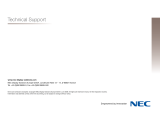Page is loading ...

NEC Displays Bring
David Hockney’s Digital Art to Life
www.necdisplay.com
Case Study
Famed British artist David Hockney has embraced new technologies
throughout his career—everything from Polaroid cameras to fax
machines—shifting between media as his own style evolves.
From Oct. 2013 to Jan. 2014, the de Young Museum in San Francisco
exhibited an expansive collection of Hockney’s work, “David Hockney:
A Bigger Exhibition,” with a focus on his recent video art and drawings
composed on iPads.
Several massive NEC Display video walls featuring the technology-
enabled work serve as a dramatic centerpiece amid conventional
paintings and drawings.
“All told, this array forms an in-depth portrait of the artist as a tradition-
fluent progressive working nonstop at the height of his powers, deftly
juggling digital and analog modes of representation and energetically
pursuing newness on several fronts,” according to the New York Times
review of the show.
Because the video walls were part of an art installation, color accuracy
and image sharpness were critical. The scale of the images required
multiple panels, so it was important that the bezels were thin enough to
produce a uniform image.
Quick Facts
Facility
• de Young Museum, Fine Arts Museums of San Francisco
Location
• San Francisco, CA
Challenges
• Displaying vibrant, large-scale video and digital art installations
Solution
• 55” NEC X551UN
Date
• October 2013
The Challenge

The screens needed to display images vibrantly no matter the lighting
conditions because the exhibit extended through several galleries,
some of which also showcased paintings. One gallery had a skylight,
while another was dark and enclosed on two sides, more along the
lines of a miniature theater. The displays also needed to be durable
enough to run all day, every day while museum guests wandered
through the show.
Case Study
The Solution
“We’ve used other screens in the past that have stopped working in
the middle of a show,” said Rich Rice, the de Young’s Audio Visual
Manager. “It’s a lot of money when you’re working with a lot of
screens, but using something that’s commercial-grade is important.”
One video wall would feature footage of the same wooded area near
Hockney’s home, filmed with a digital video camera during each of the
four seasons. Another followed jugglers moving across a stage and,
as a result, across several screens. Some of the digital video paintings
would be displayed in a static image, while others would run as a
recording of the actual painting process.
Hockney had successfully used NEC displays for other installations,
but the curator shared several possibilities with him for “A Bigger
Exhibition” since the museum was footing the bill for the large investment.
After weighing all the options, Hockney and his team decided NEC was
still the best choice.
The museum purchased two 6x3 arrays, four sets of 3x3 configurations
and eight single screens, all featuring 55-inch ultra-narrow X551UN displays.
With NEC’s true-to-life color capabilities, the vivid hues Hockney uses in
his paintings leave a stunning impression. “So many displays are bright
and nice enough, but they just don’t look real,” Rice said. “Hockney’s
colors look amazing on the NEC panels. They’re true colors, bright and
good looking.”
The ultra-narrow 3.5 mm bezels virtually disappear so the panels appear
to present a single, unified image (though Hockney likes to play with the
images a bit and purposely misalign them). The video doesn’t hesitate at
all, either, so it flows as a smooth, continuous image. And because the
displays are designed to be on all the time, the museum’s long hours
aren’t a problem—visitors don’t leave disappointed that a malfunctioning
screen prevented them from seeing the art.
In this case the museum had a different source for each screen, but
controlling the panels is simple, Rice said, with the option to insert the
input from a computer into one screen and then daisy-chain it to the rest
so they all run in sync. The configuration can just as easily display the
same image or video on each screen, or tile the image so each screen
shows a different portion of the whole.
The result has been one of the most popular exhibits ever to run at the
de Young, Rice said.
“The show was very well-received, and word got around,” Rice said.
“Even people who typically do not go to art museums were awestruck
by the large digital images. That doesn’t always happen. It was a
fantastic, grand show.”
Now that the show is over, the largest of the Hockney installations will
remain at the de Young through October 2014 and may become a
permanent exhibit. The museum has repurposed the rest of the displays
for other uses, including signage for visitors and a 4x4 grid in the exhibition
offices that curators use to look at floor plans for upcoming projects.
But even though “A Bigger Exhibition” has been mostly dismantled, it’s
left a lasting impact.
“People were mesmerized by it,” Rice said. “It was a huge success.”
© 2014 NEC Corporation NEC and the NEC logo a registered trademarks of NEC Corporation
NEC Display Solutions
500 Park Boulevard, Suite 1100
Itasca, IL 60143
866-NEC-MORE
www.necdisplay.com
DAVID HOCKNEY
3 - INSTALLATIONS SHOTS OF “A BIGGER EXHIBITION”
AT THE DE YOUNG FINE ARTS MUSEUM 2013
© DAVID HOCKNEY
PHOTO CREDIT: RANDY DODSON
IMAGES COURTESY THE FINE ARTS MUSEUMS OF SAN FRANCISCO
/


